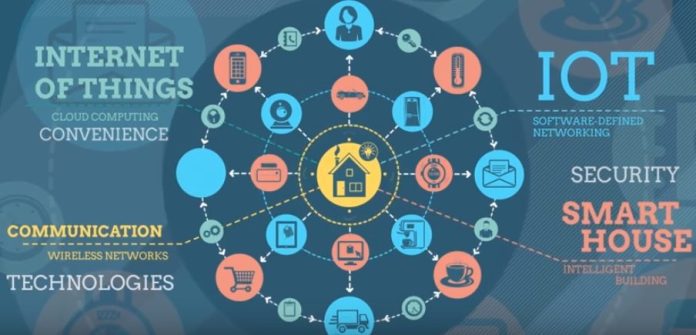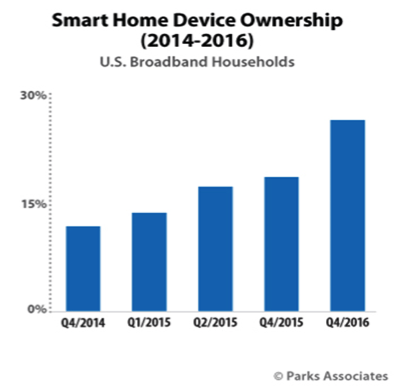Just as computing continues to evolve with new innovations (graphical interfaces, PC networks, internet connectivity, mobile devices, apps, Internet of Things), the vision of smart homes is, in step-wise fashion, becoming a reality for the mass market. Smart homes, until the past hand-full of years, were implemented only by high-end home integrators, and only to the households of the uber-wealthy. According to market researcher Parks Associates, in January 2017, smart home products are now reported to be in 26% of U.S. broadband households and are growing quickly. Still, many consumers are reluctant to see smart home products as truly valuable life-style additions. This reluctance is bred from perceptions that products are too expensive, too complex, or simply not that useful.
Two products that have leveled these barriers to adoption are smart thermostats and automated assistants such as Amazon’s Echo or Google’s Home. These products are not expensive, are simple to use, and to most homes, offer a measurable degree of utility. The fact that approximately 15 million Alexa powered products alone have been sold, and the fact that smart thermostats are now found in lower income households, signals that smart home products have moved past early adopters and into the mainstream. Alibaba’s announcement of the $73 Timwall voice assistant signals a tidal wave of voice enabled technologies soon to wash over the consumer electronics landscape.
The real value in voice assistants, however, is not just their ability to understand human speech, but is in their ability to use artificial intelligence chat bots to carry out commands. Note that your Echo is able, over time, to learn speech shortcuts. I no longer ask Alexa to “tell I Heart Radio to play radio station KTCX, Dallas.” I can now say, “Alexa, play the Ticket radio,” and it works.
“Chatbots,” which power voice assistants, are rather basic subsets to intelligent bots — sophisticated processes that are developed by capturing streams of consumer behavior data, and become more precise with more and more streams of data, such as recording the time and temperature of my last thermostat set point of each day. With voice control and bots, I can begin telling my home “set bedtime” without opening an app, switching off connected lights, arming my security system keypad, or fumbling with my thermostat. Phil Libin, former CEO of Evernote and now a venture investor in bots, told Wired, “there are going to be 100 million bots. It’s going to be similar to the app gold-rush, but magnified.”
Bots transform user experiences in several ways. First, bots eliminate the need to access devices or apps when I wish to control a system. Using voice commands, or by allowing bots to run interrupted for days or weeks, my home runs more comfortably and efficiently with minimal intervention. Secondly, bots can increase my convenience and safety by providing relevant information such as time since last air conditioning filter change, or by informing me that no one has entered the home this afternoon (when I expect my children to be returning from school).
Bots are already attracting large numbers of developers who have found that earning revenues on the app stores is now extremely difficult, as three quarters of U.S. households download zero new apps each month, according to Wired. Smart home system creator People Power Company, which has opened its smart home bots specifications to the public, has created several dozen bots that perform tasks such as detecting when a security event is a false alarm (a $100M industry problem), determining when motion is from a household pet, learning your normal lighting patterns so that they can be continued even when you are on vacation, and many more. Bots expand the functionality of your home systems far beyond the capabilities they were designed to provide – increasing their utility and value, and providing for extensive system differentiation.
By increasing homeowners’ utility, peace-of-mind and convenience, and for less than the cost of a monthly mobile phone subscription, smart home systems become more than luxuries. These systems will soon become standard equipment in the home, just as Netflix and HD televisions are now in most every home. The benefits received are, quite simply, a good value for the price.


